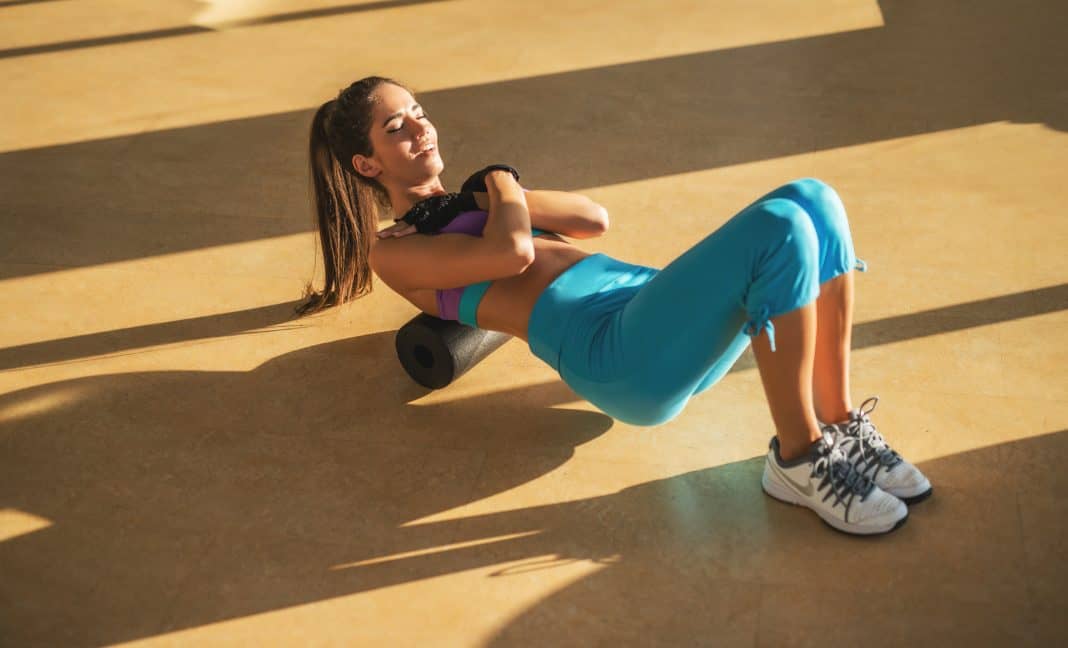One of the first things people experience after starting a new workout program is delayed onset muscle soreness (DOMS). DOMS, also called muscle fever, is the pain and stiffness felt in muscles most strongly between 24 and 72 hours after exercise. As a trainer, I’ve heard all kinds of funny comments in the days following a workout, like “my arms are so sore I couldn’t wash my hair” or “that leg workout was so hard, I think of you every time I sit on the toilet.” The truth is, my clients often complain more about DOMS than they do the workout itself–and rightly so. The minor discomfort they experience during exercise may only last an hour, but the discomfort from DOMS can last for days. One could easily say DOMS is a trainer’s worst enemy, especially if no one explains what it is and how to treat it. Although exercise itself doesn’t necessarily have to be painful to be effective, a certain level of muscle soreness and tightness often follows. This post-workout experience is completely normal but rarely welcomed. More intense training brings with it more intense discomfort after the workout. And with high-intensity training being all the rage right now, no wonder everyone is embracing the idea of rolling out the soreness with a foam roller.
How It Works
Foam rolling is becoming increasingly popular for combating DOMS. It’s basically a form of self-massage to increase range of motion, reduce tension and pain, and boost performance and energy levels. Foam rolling improves blood flow to encourage healing and is also believed to enhance flexibility and joint integrity. Most fitness experts would agree that foam rolling aids in muscle recovery and can even prevent injuries that are a result of overuse or poor form caused by tight or weak muscles. Since foam rolling has gained popularity, plenty of studies have shown that it is indeed effective for treating DOMS. In a recent study published in the Journal of Athletic Training, each participant showed substantial improvement in muscle tenderness and even an improvement in actual performance. Self-treatment involves rolling a foam roller under a specific muscle group until you find a tender spot. Once you have located a sore muscle, using your own body weight, you simply maintain pressure on that trigger point for 30 to 60 seconds. Some of the most common muscles that benefit from foam rolling are the glutes, quadriceps, hamstrings, IT band, calves, and hip flexors. Using foam rollers on the back is said to help reduce pain and improve posture. Foam rollers are normally about six inches in diameter, 12 to 36 inches long, and vary in density, texture, and construction. They come in all shapes and sizes, but most foam rollers have a hard inner core with a dense foam outer layer. Some, like the RumbleRoller, have flexible bumps for better muscle penetration, whereas traditional foam rollers have a smooth solid surface. The more popular foam rollers become, the more options there are, like the EvoFit Ensō Roller. The Ensō comes with eight adjustable discs of varying sizes, so your roller can be customized to fit the target area without pressure to surrounding muscles and bones. There are endless variations of foam rollers on the market today, but you don’t have to buy the fanciest foam roller to get results.
Pros and Cons
The best part of foam rolling, apart from the relief you get when you do it regularly, is that it’s affordable. Massage therapy can be very expensive, but you can buy a foam roller for less than the cost of one massage. Like anything else, prices vary depending on the brand and style. You can get a high-end luxury foam roller like the HyperIce VYPER, which vibrates at three different speeds ($199), or you can take the economic route with the GoFit Pro Massage Foam Roller from Target for just under $20. Although foam rolling is more affordable than massage therapy, it’s not as much fun as an actual massage, and it takes a bit of skill and knowledge to do it properly. This brings me to the downside of foam rolling. People who are already hurting aren’t too thrilled to hear the solution can also be uncomfortable. Although deep tissue massage can be equally painful, there is still something appealing about getting a massage. If you take away the fluff–lotion, relaxing music, aromatherapy, and gentle touch–you’re left with the deep tissue digging on those sensitive trigger points, which is basically what foam rolling is all about. Foam rolling is very therapeutic (read: painful). No pain, no gain, right? Unfortunately, most people would agree that foam rolling is awesome after self-treatment but quite uncomfortable during use. So you may have a painful hurdle to get over before you get some relief.
Fit or Flop?
Overall, I’d say foam rolling is a perfect fit for most fitness enthusiasts. Of course you have to do more than just buy one. You actually have to use it, but it only takes 10 to 15 minutes to get results. To ensure your investment pays off, leave your roller out where you’ll see it every day. Keep it in the living room so you can roll while you watch TV. Put it by your bed if you prefer to roll before you go to sleep or first thing when you wake up. It’s portable enough to take to the office, so you can even roll at work. The more visible it is, the more likely you are to use it.



